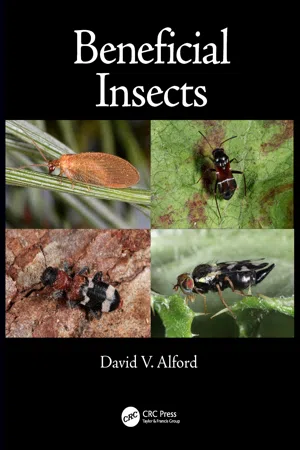![]()
Part I
Introduction and Overview
![]()
Insects (class Insecta) are members of the phylum Arthropoda, invertebrate animals characterised by their often hard exoskeleton or body shell, their segmented body and their jointed limbs. Unlike all other arthropods, adult insects usually possess two pairs of wings and three pairs of true legs. Also, the body is divided into three main sections: head, thorax and abdomen. The outer skin or integument of an insect is composed of chitin and protein, and is known as the cuticle. This forms a non-cellular, waterproof layer over the body, the precise chemical composition and thickness of which determines its hardness and rigidity. The cuticle has three layers (epicuticle, exocuticle and endocuticle) and is secreted by an inner lining of cells that form the hypodermis or basement membrane. When first produced, the cuticle is elastic and flexible, but soon after deposition it usually undergoes a period of hardening or sclerotisation, and becomes more or less darkened by the addition of a chemical called melanin. The adult cuticle is not replaceable, except in certain primitive insects. However, at intervals during the growth of the immature stages (larvae and nymphs), the ‘old’ hardened cuticle becomes too tight and is replaced by a new, initially expandable, one secreted from below. The insect cuticle is often thrown into ridges and depressions, is frequently sculptured or distinctly coloured, and may bear a variety of spines and hairs. In insect larvae, body hairs often arise from hardened plates or wart-like pinacula, tubercles and verrucae. In some groups, as in beetles (order Coleoptera), features of the adult cuticle (such as colour, sculpturing or texture) are of considerable value in distinguishing between species.
The basic body segment of an insect is divided into four sectors (a dorsal tergum, a ventral sternum and two lateral pleurons) which often form horny, chitinous plates called sclerites. These may give the body an armour-like appearance and are either fused rigidly together or are joined by soft, flexible, chitinous membranes to allow for body movement. Appendages, such as legs, are developed as outgrowths from the pleurons.
The head of an insect is composed of six fused body segments, and carries a pair of sensory antennae, eyes and mouthparts. The form of an insect antenna varies considerably, the number of so-called antennal ‘segments’ ranging from one to more than a hundred. The basal segment is called the scape, the second segment is the pedicel and from this arises the many-segmented flagellum (each segment of which is termed a flagellomere). In a geniculate (elbowed) antenna, the pedicel acts as the articulating joint between the often greatly elongated scape and the flagellum; such antennae are characteristic of certain weevils, bees and wasps. Many insects possess two compound eyes, each composed of several thousand facets, and three simple eyes called ocelli, the latter usually forming a triangle at the top of the head. Compound eyes are large and especially well developed in insects (such as predators) where good vision is important. The compound eye provides a mosaic (rather than a clear) picture, but is well able to detect movement. The ocelli are optically simple, and lack a focusing mechanism; they are concerned mainly with registering light intensity, enabling the insect to distinguish between light and shade. Insect mouthparts are derived from several modified, paired appendages; they range from simple biting jaws (mandibles) to complex structures for piercing, sucking or lapping. Amongst plant-feeding (phytophagous) insects, biting mouthparts are found, for example, in adult and immature grasshoppers, locusts, earwigs and beetles, but (as in butterflies and moths) may be restricted to the larval stages. Stylet-like, suctorial mouthparts are characteristic of thrips and true bugs (including aphids); such insects may introduce toxic saliva into plants and cause distortion or galling of the tissue. Some biting or sucking insects transmit plant viruses or other pathogens to host plants.
The thorax has three segments (the prothorax, the mesothorax and the metathorax), whose relative sizes vary from one insect group to the next. In beetles, for example, the prothorax is the largest section and is covered on its upper surface by an expanded dorsal sclerite called the pronotum; in true flies, the mesothorax is greatly enlarged and the prothoracic and metathoracic segments are much reduced. Typically, each thoracic segment bears a pair of jointed legs. Their form varies considerably, but all have the same basic structure: the main components being the coxa (basally), the femur, the tibia and the tarsus (the latter subdivided into several so-called ‘segments’ or tarsomeres). Wings, when present, arise from the mesothorax and the metathorax as a pair of forewings and hindwings, respectively. Basically, each wing is an expanded membrane-like structure supported by a series of hardened veins, but considerable modification has taken place in the various insect groups. In certain insects, as in the case of mirid bugs, the forewings (then termed hemelytra) are leathery basally but membranous apically. Further, in earwigs and beetles, the forewings have become hardened and thickened protective flaps, called elytra, and only the hindwings are used for flying; in true flies, the forewings retain their propulsive function, but the hindwings have become greatly reduced in size and are modified into balancing organs known as halteres. Details of wing structure and venation are of importance in the classification and identification of insects, and the...
